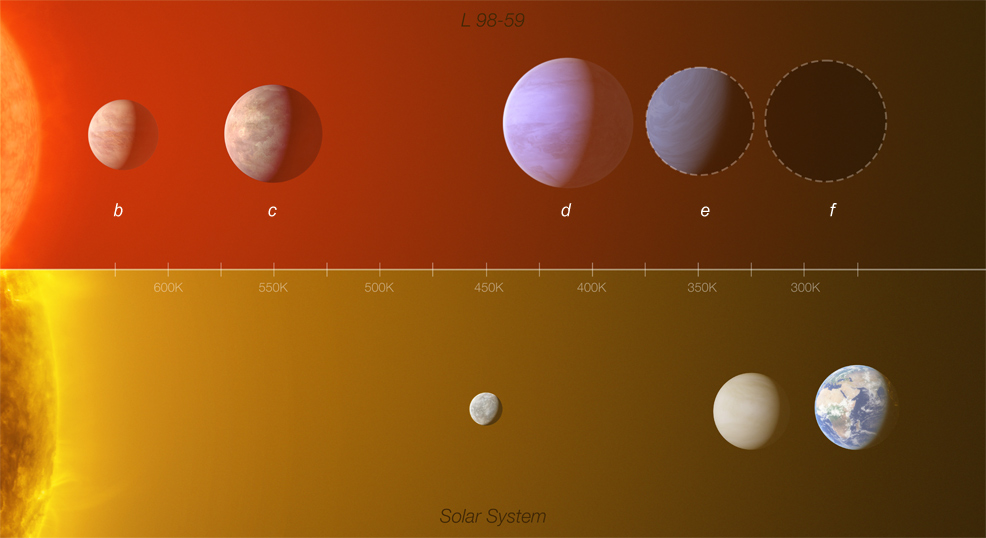
11th August 2021 New observations of exoplanets in the L 98-59 system New observations of the M-type star L 98-59 and its surrounding system have revealed a planet with half the mass of Venus, making it the lightest exoplanet ever to be measured using the radial velocity method. Alongside this are a likely water world, and a possible planet in the habitable zone.
L 98-59 is an M3 dwarf star with about 31% of our Sun's mass and radius, located in the constellation of Volans about 35 light years away. A previous study using the Transiting Exoplanet Survey Satellite (TESS) had detected three inner terrestrial-sized planets, announced in March 2019. Astronomers from the European Southern Observatory (ESO) have now made follow-up observations using the Very Large Telescope (VLT) in Chile, confirming an additional fourth planet, and hints of a fifth planet, along with more details about the already known ones in the inner part of the system. The newly spotted fourth world (designated L 98-59 e) weighs in at 3.1 Earth masses and is believed to be a "super Venus". The fifth world (L 98-59 f) is estimated at 2.46 Earth masses and is the most distant from its star. Both are in the band where liquid water might exist on their surfaces – but the fifth lies in a particularly favourable part of the "goldilocks zone" that is remarkably similar to Earth. If confirmed by future studies, the latter is therefore the more promising of the two in terms of suitability for life. The ESO team's observations of the inner three worlds (b, c, and d) confirmed that the planet closest to the star is around half the mass of Venus, making it the lightest exoplanet ever detected using the radial velocity technique. Their new insights also revealed that the two innermost planets, although thought to be hot, dry and rocky worlds, might hold small amounts of water. The third planet is 1.9 Earth masses, and the astronomers believe that 30% of its mass is water.
To study the L 98-59 system, the team used Echelle SPectrograph for Rocky Exoplanets and Stable Spectroscopic Observations (ESPRESSO), an instrument installed on the VLT in 2016. This can measure tiny shifts in the spectrum of a star, through the Doppler effect, caused by the gentle gravitational pull of a planet that drags a system's barycentre – its centre of gravity – slightly away from the centre of a star. This "tug of war" between host stars and their exoplanets can be seen (or rather, measured indirectly) with extreme precision. An earlier instrument, HARPS, detected stellar motions of 3.5 km/h. The newer ESPRESSO instrument is even more sensitive, able to detect motions of just 0.35 km/h. The ESO researchers determined that the innermost planet is only 0.4 Earth masses, using this technique. "Without the precision and stability provided by ESPRESSO, this measurement would have not been possible," said María Rosa Zapatero Osorio, an astronomer at the Centre for Astrobiology in Madrid, Spain, and one of the authors of a study published in Astronomy and Astrophysics. "This is a step forward in our ability to measure the masses of the smallest planets beyond the Solar System." The team hopes to use the forthcoming James Webb Space Telescope (JWST), successor to Hubble, to continue studying this system. The JWST is due for launch in November or December of this year. The ESO's Extremely Large Telescope (ELT), currently under construction in the Chilean Atacama Desert and scheduled for completion in 2025, will also be ideal for studying these exoplanets. "This system announces what is to come," said Olivier Demangeon, a postdoctoral researcher at the Instituto de Astrofísica e Ciências do Espaço, University of Porto in Portugal and lead author of the new study. "We, as a society, have been chasing terrestrial planets since the birth of astronomy and now we are finally getting closer and closer to the detection of a terrestrial planet in the habitable zone of its star, of which we could study the atmosphere."
Comments »
If you enjoyed this article, please consider sharing it:
|








